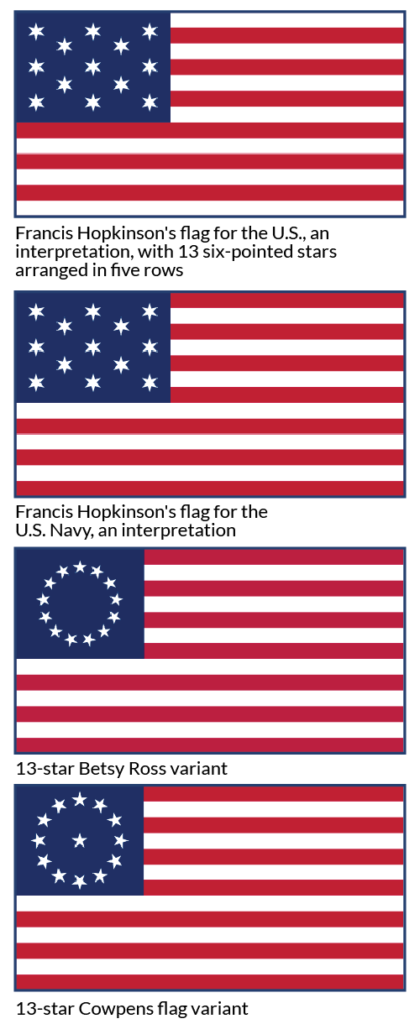Designer of the First Stripes and Stars
Francis Hopkinson of New Jersey, a naval flag designer and a signer of the Declaration of Independence, designed a flag in 1777 while he was the chairman of the Continental Navy Board’s Middle Dept. Hopkinson also claimed that he designed a flag for the U.S. Navy. Hopkinson was the only person to have made such a claim during his own life when he sent a letter and several bills to Congress for his work. Hopkinson initially wrote a letter to Congress, via the Continental Board of Admiralty, on May 25, 1780. In this letter, he asked for a “Quarter Cask of the Public Wine” as payment for designing the U.S. flag, the seal for the Admiralty Board, the seal for the Treasury Board, Continental currency, the Great Seal of the United States, and other devices.
 However, in three subsequent bills to Congress, he asked to be paid in cash, but instead of his U.S. flag design, he asked to be paid for designing the “great Naval Flag of the United States” in the first bill; the “Naval Flag of the United States” in the second bill; and “the Naval Flag of the States” in the third, along with the other items. The flag references were generic terms for the naval ensign that Hopkinson had designed: a flag of seven red stripes and six white ones. The predominance of red stripes made the naval flag more visible against the sky on a ship at sea. By contrast, Hopkinson’s flag for the U.S. had seven white stripes and six red ones – in reality, six red stripes laid on a white background.
However, in three subsequent bills to Congress, he asked to be paid in cash, but instead of his U.S. flag design, he asked to be paid for designing the “great Naval Flag of the United States” in the first bill; the “Naval Flag of the United States” in the second bill; and “the Naval Flag of the States” in the third, along with the other items. The flag references were generic terms for the naval ensign that Hopkinson had designed: a flag of seven red stripes and six white ones. The predominance of red stripes made the naval flag more visible against the sky on a ship at sea. By contrast, Hopkinson’s flag for the U.S. had seven white stripes and six red ones – in reality, six red stripes laid on a white background.
Hopkinson’s sketches have not been found, but we can make these conclusions because Hopkinson incorporated different stripe arrangements in the Admiralty (naval) Seal that he designed in the Spring of 1780 and the Great Seal of the United States that he proposed at the same time. His Admiralty Seal had seven red stripes; whereas his second U.S. Seal proposal had seven white ones. Remnants of Hopkinson’s U.S. flag of seven white stripes can be found in the Great Seal of the United States and the President’s seal. When he was chairman of the Navy Board, his position was like that of today’s Secretary of the Navy. The payment was not made, most likely, because other people had contributed to designing the Great Seal of the United States, and because it was determined he already received a salary as a member of Congress. This contradicts the legend of the Betsy Ross flag, which suggests that she sewed the first Stars and Stripes flag at the request of the government in Spring 1776.
On May 10, 1779, a letter from the War Board to George Washington stated that there was still no design established for a national standard, on which to base regimental standards, but also referenced flag requirements given to the board by General von Steuben. On September 3rd, Richard Peters submitted to Washington “Drafts of a Standard” and asked for his “Ideas of the Plan of the Standard,” adding that the War Board preferred a design they viewed as “a variant for the Marine Flag.” Washington agreed that he preferred “the standard, with the Union and Emblems in the center.” The drafts are lost to history but are likely to be similar to the first Jack of the United States.
The origin of the stars and stripes design has been muddled by a story disseminated by the descendants of Betsy Ross. The story credits Ross for sewing one of the first flags from a pencil sketch handed to her by George Washington. No such evidence exists either in Washington’s diaries or the Continental Congress’s records.
Indeed, nearly a century passed before Ross’s grandson, William Canby, first publicly suggested the story in 1870. By her family’s own admission, Ross ran an upholstery business, and she had never made a flag as of the visit in June 1776. Furthermore, her grandson admitted that his own search through the Journals of Congress and other official records failed to find corroborating evidence for his grandmother’s story.
George Henry Preble states in his 1882 text that no combined stars and stripes flag was in common use prior to June 1777, and that no one knows who designed that flag. Historian Laurel Thatcher Ulrich argues that there was no “first flag” worth arguing over. Researchers accept that the United States flag evolved, and did not have one design. Marla Miller writes, “The flag, like the Revolution it represents, was the work of many hands.” The family of Rebecca Young claimed that she sewed the first flag. Young’s daughter was Mary Pickersgill, who made the Star-Spangled Banner Flag.
She was assisted by Grace Wisher, a 13-year-old African American girl.
Read more articles from VOM Magazine here: https://www.veteransoutreachministries.org/vom-magazine/





